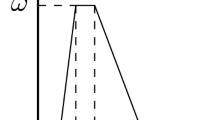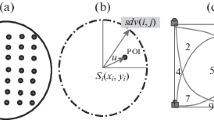Abstract
The Internet of Things (IoT) enables intelligent and heterogeneous things to access the Internet and subsequently interact and share info. A service management methodology is required by growing IoT applications and the number of services supplied by various objects. Nevertheless, making decisions, finding, and choosing a service is complex. Therefore, numerous techniques are explored in this regard. This paper employed Flower Pollination Algorithm (FPA) for service discovery and selection in IoT. The FPA is a nature-inspired algorithm that mimics flowering plant pollination behavior. Through a hand-over probability, it is possible to adjust the balance between local and global search properly. The survival of the fittest and the optimal reproducing plants regarding numbers are parts of an optimum plant reproduction strategy. These elements are optimization-oriented and constitute the FPA’s basics. The suggested methodology has an excellent performance in minimizing data access time, energy usage and optimizing cost according to simulation findings.









Similar content being viewed by others
Data Availability
All data are reported.
References
Ghanbari, Z., Jafari Navimipour, N., Hosseinzadeh, M., & Darwesh, A. (2019). Resource allocation mechanisms and approaches on the Internet of Things. Cluster Computing, 22(4), 1253–1282.
Ahmed, M.I. and G. Kannan, (2021). Secure End to End Communications and Data Analytics in IoT Integrated Application Using IBM Watson IoT Platform. Wireless Personal Communications.
Li, B., Feng, Y., Xiong, Z., Yang, W., & Liu, G. (2021). Research on AI security enhanced encryption algorithm of autonomous IoT systems. Information Sciences, 575, 379–398.
Lee, H., Chow, R., Haghighat, M. R., Patterson, H. M., & Kobsa, A. (2018). IoT service store: A web-based system for privacy-aware IoT service discovery and interaction. in 2018 IEEE International Conference on Pervasive Computing and Communications Workshops (PerCom Workshops). IEEE.
Cai, K., Chen, H., Ai, W., Miao, X., Lin, Q., & Feng, Q. (2021). Feedback Convolutional Network for Intelligent Data Fusion Based on Near-infrared Collaborative IoT Technology. IEEE Transactions on Industrial Informatics.
Sadrishojaei, M., Navimipour, N. J., Reshadi, M., & Hosseinzadeh, M. (2022). A new clustering-based routing method in the mobile internet of things using a krill herd algorithm. Cluster Computing, pp. 1–11.
Guinard, D., Trifa, V., Karnouskos, S., Spiess, P., & Savio, D. (2010). Interacting with the soa-based internet of things: Discovery, query, selection, and on-demand provisioning of web services. IEEE Transactions on Services Computing, 3(3), 223–235.
Lizcano, D., Jiménez, M., Soriano, J., Cantera, J. M., Reyes, M., Hierro, J. J., & Tsouroulas, N. (2008). Leveraging the upcoming internet of services through an open user-service front-end framework. in European Conference on a Service-Based Internet. Springer.
Yi, H., (2021). Secure Social Internet of Things Based on Post-Quantum Blockchain. IEEE Transactions on Network Science and Engineering.
Georgakopoulos, D., Jayaraman, P. P., Zhang, M., & Ranjan, R. (2015). Discovery-driven service oriented IoT architecture. in 2015 IEEE Conference on Collaboration and Internet Computing (CIC). IEEE.
Khalil, A., N. Mbarek, and O. Togni, (2021). A Self-Optimizing QoS-Based Access for IoT Environments. Wireless Personal Communications.
Eceiza, M., J.L. Flores, and M. Iturbe, (2021). Fuzzing the Internet of Things: A Review on the Techniques and Challenges for Efficient Vulnerability Discovery in Embedded Systems. IEEE Internet of Things Journal.
G Sun Y Cong Q Wang B Zhong Y Fu (2020). Representative task self-selection for flexible clustered lifelong learning IEEE Transactions on Neural Networks and Learning Systems
Baek, K. and I.-Y. Ko. (2018). Spatio-cohesive service selection using machine learning in dynamic IoT environments. in International Conference on Web Engineering. Springer, Cham
Sim, S., & Choi, H. (2020). A study on the service discovery support method in the IoT environments. The International Journal of Electrical Engineering & Education, 57(1), 85–96.
Li, K., Xu, G., Zhao, G., Dong, Y., & Wang, D. (2021). Cloud task scheduling based on load balancing ant colony optimization. in 2011 sixth annual ChinaGrid conference. IEEE.
Parra-Hernandez, R., & Dimopoulos, N. J. (2005). A new heuristic for solving the multichoice multidimensional knapsack problem. IEEE Transactions on Systems, Man, and Cybernetics-Part A: Systems and Humans, 35(5), 708–717.
Xia, H., Hu, C. Q., Xiao, F., Cheng, X. G., & Pan, Z. K. (2019). An efficient social-like semantic-aware service discovery mechanism for large-scale Internet of Things. Computer Networks, 152, 210–220.
Singla, C., Mahajan, N., Kaushal, S., Verma, A., Sangaiah, AK., (2018). Modelling and analysis of multi-objective service selection scheme. In IoT-cloud environment Cognitive computing for big data systems over IoT, Springer, Cham. pp.63 77
Ben-Sassi, N., Dang, X. T., Fähndrich, J., Görür, O. C., Kuster, C., & Sivrikaya, F. (2018). Service Discovery and Composition, In Smart Cities. In International Conference on Advanced Information Systems Engineering. Springer, Cham.
Zannou, A., & Boulaalam, A. (2021). Relevant node discovery and selection approach for the Internet of Things based on neural networks and ant colony optimization. Pervasive and Mobile Computing, 70, 101311.
Bensalah Azizou, Z., Boudries, A., & Amad, M. (2020). Decentralized service discovery and localization in Internet of Things applications based on ant colony algorithm. International Journal of Computing and Digital Systems, 9(5), 941–950.
Osman, W., Abdelsalam, H., Ali, M., Teleb, N. H., Yahia, I. S., Ibrahim, M. A., & Zhang, Q. (2021). Electronic and magnetic properties of graphene quantum dots doped with alkali metals. Journal of Materials Research and Technology, 11(1517), 1533.
Yachir, A., Amirat, Y., Chibani, A., & Badache, N. (2016). Event-aware framework for dynamic services discovery and selection in the context of ambient intelligence and Internet of Things. IEEE Transactions on Automation Science and Engineering, 13(1), 85–102.
Teng, H., Dong, M., Liu, Y., Tian, W., & Liu, X. (2021). A low-cost physical location discovery scheme for large-scale Internet of Things in smart city through joint use of vehicles and UAVs. Future Generation Computer Systems, 118, 310–326.
Singh, M., Baranwal, G., & Tripathi, A. K. (2020). QoS-Aware Selection of IoT-Based Service. Arabian Journal for Science and Engineering, 45(12), 10033–10050.
Safaei, B., Monazzah, A. M. H., & Ejlali, A. (2020). ELITE: An elaborated cross-layer RPL objective function to achieve energy efficiency in internet-of-things devices. IEEE Internet of Things Journal, 8(2), 1169–1182.
Rathee, G., Garg, S., Kaddoum, G., & Choi, B. J. (2020). A decision-making model for securing IoT devices in smart industries. IEEE Transactions on Industrial Informatics, 17(6), 4270–4278.
Sefati, S. S., & Tabrizi, S. G. (2021). Cluster head selection and routing protocol for wireless sensor networks (WSNs) based on software-defined network (SDN) via game of theory. Journal of Electrical and Electronic Engineering, 9(4), 100–115.
Zhang, W., Yang, Y., Zhang, S., Yu, D., & Xu, Y. (2016). A new manufacturing service selection and composition method using improved flower pollination algorithm. Mathematical Problems in Engineering.
Storn, R., & Price, K. (1997). Differential evolution—A simple and efficient heuristic for global optimization over continuous spaces. Journal of global optimization, 11(4), 341–359.
Alsaryrah, O., I. Mashal, and T.-Y. (2018). Chung. Energy-aware services composition for Internet of Things. in 2018 IEEE 4th World Forum on Internet of Things (WF-IoT). IEEE.
Alyasseri, Z. A. A., Khader, A. T., Al-Betar, M. A., Awadallah, M. A., & Yang, X. S (2018). Variants of the flower pollination algorithm: a review. Nature-Inspired Algorithms and Applied Optimization, pp. 91–118.
Bell, A.D.B., An illustrated guide to flowering plant morphology/Adrian D. Bell; with line drawings by Alan Bryan.
Glover, B. J. (2007). Understanding flowers and flowering: An integrated approach (Vol. 277). Oxford University Press.
X-S Yang (2012). Flower pollination algorithm for global optimization. Unconventional Computation and Natural Computation, Springer, Berlin, pp. 240-249
Abdel-Basset, M., & Shawky, L. A. (2019). Flower pollination algorithm: A comprehensive review. Artificial Intelligence Review, 52(4), 2533–2557.
Corazza, M., Fasano, G., & Gusso, R. (2013). Particle Swarm Optimization with non-smooth penalty reformulation, for a complex portfolio selection problem. Applied Mathematics Computation, 224, 611–624.
Funding
No Funding.
Author information
Authors and Affiliations
Contributions
The authors contributed equally in all parts of the paper.
Corresponding author
Ethics declarations
Conflict of Interest
The authors declare no competing interests.
Consent to Participate
I believe the participant is giving informed consent to participate in this study.
Consent to Publish
The Author transfers to Springer the non-exclusive publication rights and warrants that the contribution is original.
Ethical Approval
The submitted work is original and has not been published elsewhere in any form or language.
Additional information
Publisher's Note
Springer Nature remains neutral with regard to jurisdictional claims in published maps and institutional affiliations.
Rights and permissions
Springer Nature or its licensor holds exclusive rights to this article under a publishing agreement with the author(s) or other rightsholder(s); author self-archiving of the accepted manuscript version of this article is solely governed by the terms of such publishing agreement and applicable law.
About this article
Cite this article
Tabrizi, S.G., Navimipour, N.J., Danesh, A.S. et al. A New Decision-Making Method for Service Discovery and Selection in the Internet of Things Using Flower Pollination Algorithm. Wireless Pers Commun 126, 2447–2468 (2022). https://doi.org/10.1007/s11277-022-09604-2
Accepted:
Published:
Issue Date:
DOI: https://doi.org/10.1007/s11277-022-09604-2




